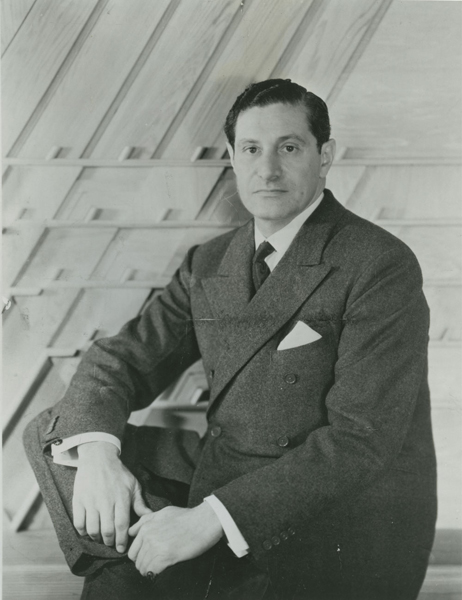

Partner Paul Mayén, buried together
Queer Places:
Fallingwater, 1491 Mill Run Rd, Mill Run, PA 15464
Columbia University (Ivy League), 116th St and Broadway, New York, NY 10027
The Museum of Modern Art, 11 W 53rd St, New York, NY 10019
 Edgar Kaufmann Jr. (April 9, 1910 – July 31, 1989) was an American
architect, lecturer, author, and an adjunct professor of architecture and art
history at Columbia University.[1]
Edgar Kaufmann Jr. (April 9, 1910 – July 31, 1989) was an American
architect, lecturer, author, and an adjunct professor of architecture and art
history at Columbia University.[1]
He was the son of Edgar J. Kaufmann, a wealthy Pittsburgh businessman and philanthropist who owned Kaufmann's department store, and his wife Liliane. Kaufmann Jr. attended the School for Arts and Crafts at the Austrian Museum of Applied Art in Vienna, in the late 1920s. He studied painting and typography for three years with Victor Hammer in Florence.[1]
After reading Frank Lloyd Wright's autobiography, Kaufmann decided to become a resident apprentice in architecture at Wright's Taliesin East School and Studio from 1933 to 1934.[2] According to fallingwater.org, he was particular about spelling his name "Edgar Kaufmann jr."[3][4]
When he left Wright's Taliesin Fellowship in 1935, he joined the family business and became merchandise manager for home furnishings, and in 1938, was elected secretary of the Kaufmann Department Stores, Inc.[5] In 1940, Edgar wrote to Alfred Barr of the Museum of Modern Art, proposing the Organic Design in Home Furnishings Competition, won by Charles Eames and Eero Saarinen. That same year, he left Kaufmann's to join the Museum of Modern Art.[1]
He served with the Army Air Forces from 1942 to 1946 during World War II. Afterwards, he was director of the Industrial Design Department at the Museum of Modern Art (MOMA) in New York City.[6] Edgar's greatest accomplishment during his tenure at MOMA was the 'Good Design' program of 1950 to 1955, in which the museum joined with the Merchandise Mart in Chicago, promoting good design in household objects and furnishings.[7]
From 1963 to 1986, Kaufmann was an adjunct professor of Architecture and Art History at Columbia University. He authored several books on Wright architecture and modern design,[8][9] and was a contributor to Arts + Architecture journal and Encyclopædia Britannica.[1]
Kaufmann strongly supported his father's decision to commission Frank Lloyd Wright for the famous 1936 Fallingwater house over Bear Run, in Stewart Township, Fayette County, Pennsylvania. After his father's death in 1955, Kaufmann inherited the Fallingwater house, continuing to use and share it as a mountain retreat until 1963.[2] Then, he entrusted the Wright structures and several hundred acres of the surrounding pristine Laurel Highlands lands in the Allegheny Mountains to the Western Pennsylvania Conservancy as an architectural house museum and conservation open space preserve, in memory of his parents.[1]
Kaufmann, who did not marry and had no children, died in 1989.[1] His ashes were scattered around the property at Fallingwater[10] by his partner Paul Mayén,[1][11] with whom he shared his life since the 1950s.[12] Mayén oversaw the building of the Fallingwater pavilion from 1979 to 1981, which houses the café, gift store, and visitor’s center at Fallingwater. Following his own death in 2000, Mayén's ashes were also scattered at Falling Water in accordance with his wishes.[12][13][14]
Museum of Modern Art, 11 W 53rd St, New York, NY 10019
My published books: